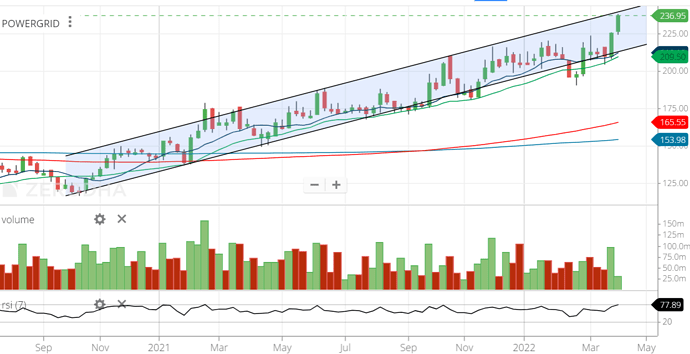How could we explain the huge valuation difference of PGCIL compared to private players like Adani Transmission? Are the following enough to explain such a difference?
- introduction of Tariff Based Competitive Bidding (TBCB)
- entry of private players and a PSU discount (?)
- muted growth in comparison
If the requests of private sector transmission companies, this could take away the advantage of Powergrid and also become a risk to future orderbook.
Went through the Q3 FY 22 Concall and had some interesting takeaways. I am just mentioning the ones that I found the most interesting.
-
The CAPEX target for FY23 is 8500 crores. If we take the current cash flow run rate, they will have a FCF of about 20000 crs= 28000 (approx)- 8500 crs. That is simply unbelievable. This means that currently the company is trading at about 6xFY23 FCF.
-
The biggest highlight of this call for me
was that they are going into new areas of smart metering, solar projects and data centres. I had no idea that they were interested in solar and data centres. Don’t think that anyone has mentioned this here.
While smart metering won’t have much effect, solar projects and data centres require massive capital with longer gestation periods, this is perfect for powergrid with the amount of FCF it is going to generate.
-
Company is going to carry out a 100 MW solar power project at some land in Manesar. From what I could understand it is their own land.
-
Going to invest 350 crs. in data centres next year.
Going forward if the company starts investing big in data centres and solar projects, it could become the perfect growth and FCF machine.
Hi Chaitanya,
Freecashflow generation will be high because of very high asset commissioning (+ invit monetization), I have also mentioned this in the past. However, they will now struggle for growth as the kind of cashflows that are thrown by transmission division cannot be absorbed in any other venture (and then produce high returns). If you look at my post below, you will clearly see that Powergrid’s competitive edge is in building and maintaining transmission lines. They have not scaled even 1 other business venture (be it consultancy or telecom) at faster rates than their base business growth. So before getting excited about solar projects, data centres, etc. we should also look at their track record.
Hi Harsh,
Agreed that they will not have many avenues to reinvest relative to their FCF generation. However, my targeted XIRR is about 20-25%. In this year itself, they have given over 10% dividend yield (expecting another 2% in the next quarter). At least 5% earnings growth can come from a decrease in interest cost (very conservatively in my opinion) and another 5% from capitalization and realization of revenue from new assets. In earnings terms only they are getting 10% growth and another 10% from dividends. And currently, they haven’t included the 29,000 cars of orders that they received under RTM for Leh and Gujarat in their calculations of CAPEX.
On the part of them venturing into new fields. I agree that they have been incapable of scaling any other business. One of the major reasons for it is that the addressable market for these itself was very small. However, both data centers and solar projects have a large addressable market. Additionally, they also talked about how they have gained some experience in energy storage technology.
I am not counting on these non-core businesses while making my thesis for investment into it. But this does give some room for a positive surprise. What gave me a bit of confidence that they will be scaling up their non-core businesses was that the management explicitly stated that they are aware of this problem.
Another statement that gives me some confidence in future stock returns is that the management said that now that their leverage is below 2:1 and now they can look at doing buybacks. I have read that in the past companies like TCS gave good stock returns even without high earnings growth because they did buybacks to decrease the float and increase the EPS. Now that both NMDC and HPCL have done buybacks, this sets precedent for other PSUs to do this also.
Apologies in advance if some information has been misinterpreted by me. Am a new investor, still trying to understand the businesses. Would love to get your view on this.
Instead of going for buyback and investments in non core businesses, i think they should try to deleverage the balance sheet first. It is also a way to boost EPS in better way.
Powergrids stock chart from the time InVIT news first came out shows how quality investors embrace companies which put serious effort on changing the perception of investor community by improving the key financial metrices including improvement in working capital days, planned and targeted deleveraging of balances sheet and concentration on ROCE.
Buyback of shares at an attractive value is what i believe the management should do next.
Disclosure: Invested - views are biased.
AJ
I am new to investment community. My questions may look very basics. But just want to understand how grid works before investing on it
- When a grid is already laid from particular destination to another… Can a new power generator use existing line to transmit the power
Ex - Indus towers - Once a tower is placed in a city. Any number of telecom player can pay rent and use the tower for their service.
Will grid lines work same way? A same grid can be used my many players …
-
Is there any limit in transmitting power through the grid lines?. If powergrid want to increase the capacity. Can it charge additional amount to the customer for increasing the grid capacity or upgrading grid lines…
-
Adani have been aggressively acquiring many transmission project in recent times. What is the moat that powergrid have to compete with private players in future…
-
3 big players in power generation - RIL, TATA, Adani… The projects they undertake, will they lay their own transmission lines for intracity or approach powergrid for their services… Because most of the new power generation is done by these 3 private players…
Reason why PowerGrid is falling so much
Power Ministry is in talks with Power Grid to purchase PFC’s 52.63% stake in REC. This is a near term dampener & could negatively impact FY23-25 EPS by 3-5%. Dividend yield could also be low at 4% vs 6% in FY23.
Sorry can you help explain relationship between powergrifld/ PFC
They both are owned by ministry of power?
Shouldn’t that push PFC up? Powergrid will be paying them cash and it can push the dividends up
PFC will use this cash to lend for power projects. Not for dividend.
Reg PowerGrid, this seems to be an over reaction even assuming the transaction actually goes through.
Denied by sources. But the market will wonder if it indeed was on the table and only canceled seeing the market reaction? Might remain a bit of an overhang on the multiple for a while IMO.
PGCIL has two types of assets:
-
Regulated Tariff Mechanism (Cost Plus) - Here the ROE is capped at 15% - All other costs are reimbursed. Most of the assets for PGCIL fall under this category.
-
Tariff Based Competitive Bidding (TBCB) - Awarded through competitive bidding. Theoretically speaking, the ROE here can be more than 15%. However, the current rounds of bidding have been extremely aggressive with new players entering the market (likes of GR Infra, Indigrid, Renew etc).
Industry players would choose RTM projects over TBCB any day.
India is actively working towards a vision to have an interconnected power grid across the South Asian region covering as many countries as feasible, said Mr Ajay Tiwari, additional secretary, Ministry of Power at CII South Asia (BBIN) Power Summit on Friday. He estimated that going by the current pace and trajectory, India is likely to source about 62% of its energy requirements from non-fossil sources by 2030, exceeding the target it has set for itself for sourcing about 50% of energy requirements from non-fossils sources by that year. In 2022, India is already sourcing about 42% of its energy requirements from non-fossils sectors. India today has a very robust power grid running from North to South and East to West of the country. In future we would like to see the grid connected to neighbouring countries including Myanmar, Sri Lanka, and then expand that connection to Southeast Asian Countries, to emerge as a unified market Mr Tiwari said. That will mean sharing of countries’ resources, investments, keeping the goals of energy security and affordability in mind. We are already working on that vision at a government-to-government level, as well as at a technocratic level to strengthen the grid interconnections between India and Nepal as well as India and Bhutan, said Mr Tiwari. There is a proposal on the same lines from India to Bangladesh, which has received encouraging and positive feedback, he indicated. Under the One Sun, One Word, One Grid Initiative, the Central Public Sector Enterprise Power Grid Corporation of India has drawn up several plans, said Mr Tiwari. The vision is to finally have an interconnected grid with Gulf Countries, and via Gulf countries to Africa and up north with Europe pointed out Mr Tiwari, adding that plans are also being drawn to connect grids from India to Myanmar, Myanmar to Thailand, Thailand to Singapore.
I feel this will mean enormous upsurge in the capital expenditure as well as profile of the company.
Disclaimer: A small investment in the company.
posting this as it may be helpful:
@harsh.beria93 few questions regarding powergrid and InvITs.
- When you say the contracts are TBCB, what is the metric on which the bidding happens? Is it cost charged per Circuit KM, or does even the amount of power transmitted also comes into play?
- With the introduction of InvIT structure, I am getting the feeling that slowly PowerGrid will become a EPC player of sorts operating on the BOT model, which sets-up the towers (builds), operates it for sometime and then transfers the towers to the InvIT. This way, isnt PowerGrid’s cashflows actually come under more stress say two three years down the line, when the towers and its profits are out of its balance sheet, and all the profits and cashflows are sitting with the InvIT
- Any idea on how the transfer of the tower assets happens between Powergrid and the InvIT, is it on book value or its like some discounted cashflows
From what I have gathered through the thread, it seems the InvIT might be a better instrument to buy due to the following:
-
Assets are created, with contracts in place, so no execution risk
-
Optionalities of possible other monetizations are with the InvIT (eg. putting telecom towers on the power towers and earning more income)
-
No/limited downside vis-a-vis Powergrid, as it gets the experience of the Powergrid mgmt. with powergrid sorting all the setup related activities (eg. land-acquisition, getting the power agreements, bidding for it etc.)
Its like PowerGrid finds a golden goose, feeds its, sees it grow and then one day sell it off to some-one for money right now compared to golden egg coming in month-over-month like annuity.
It would be great if you can shed some light on the questions and also let me know if I am missing on . PowerGrid vs PowerGrid InvIT view




